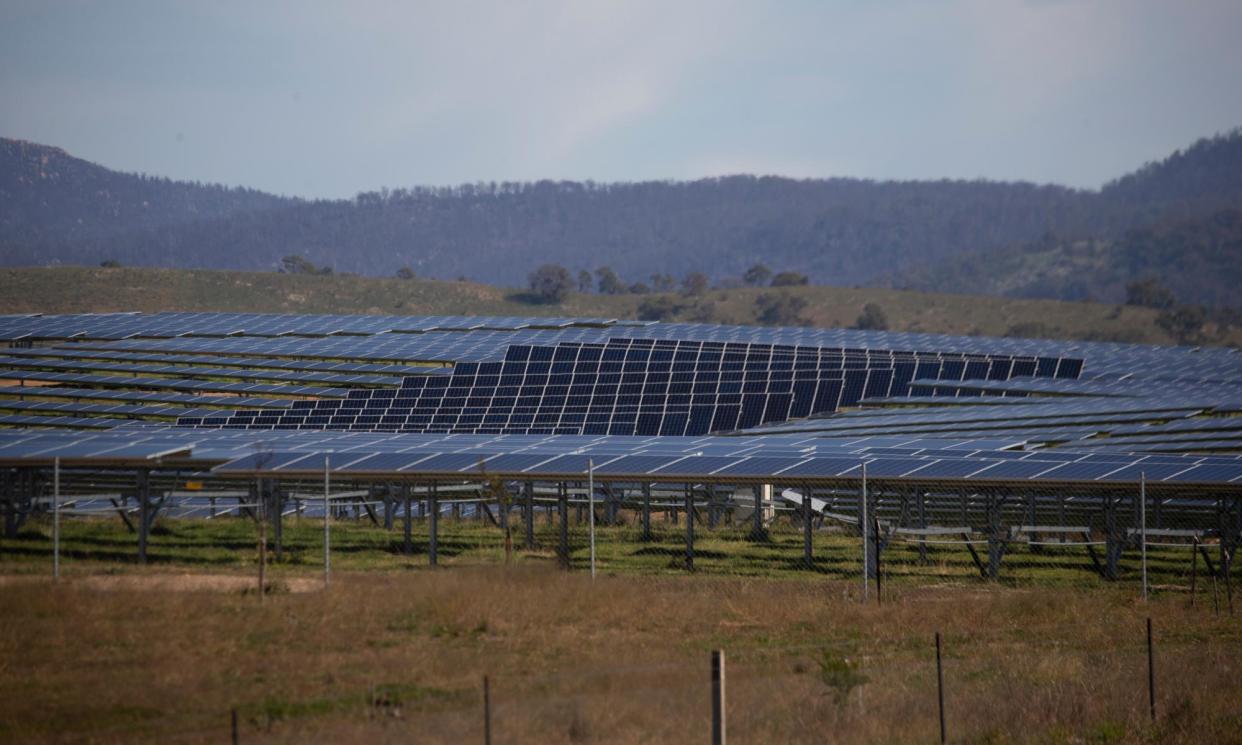NSW lagging on rollout of renewables meaning Australia could miss 2030 clean energy target

New South Wales has the largest gap between its 2030 emissions reduction goals and the present pace of renewables rollout among the states, a performance that will make it harder for Australia to meet national goals unless addressed, a new report argues.
The report, by Green Energy Markets, said NSW’s legislated electricity infrastructure roadmap indicates the state would need to generate 33,600 gigawatt hours of renewable energy from projects in place by the end of 2029.
On this score, NSW was less than halfway to its goal with forecast output from projects already committed or contracted at about 12,911GWh as of the end of 2023. Those projects amounted to just over 6GW of capacity, leaving the state with almost 7.5GW more in wind and solar farms needed to hit the target.
For Queensland, the capacity shortfall was about 2.6GW given a “remarkable” recent pace of approvals, with South Australia’s at 2.445GW. Victoria was now less than 1GW shy of the needed capacity to meet its own target of 60% renewables by 2030, while Western Australia already had enough projects either under construction, contracted or government-funded to meet its goal.
The Albanese government’s 82% renewable energy target for the grid by 2030 was already going to be a stretch as the federal goal was greater than what the states themselves were aiming for, the report said.
Still, as the biggest electricity generator, NSW was “the chokepoint” for the national transition off fossil fuels, said Tristan Edis, a senior Green Energy Markets analyst and an author of the report. It was time for planners “to take their foot off the pedal”, he said.
NSW largely dodged major strains on its power grid this summer with heatwaves for main population centres, including Sydney, mostly limited to single-day events.
But the state’s challenges may worsen in the near term. Australia’s largest power station – the 2.88GW Eraring coal-fired plant – is slated to shut by August 2025. Talks over an extension continue between NSW and owner Origin, with its exit to remove about a quarter of the NSW’s so-called baseload generation capacity.
The Minns Labor government said it was stepping up the pace of approvals with 18 “significant” wind, solar and battery projects getting the nod in 2023. A planning department spokesperson told Guardian Australia the state government was presently assessing 29 renewable energy projects.
“It is also awaiting development applications and [environmental statements] for more than 70 new projects from industry,” the spokesperson said, adding the department aimed “to determine up to 50 new energy projects in 2024 with a combined generation and storage capacity of up to 25 gigawatts”.
The NSW planning minister, Paul Scully, told the Smart Energy Council’s conference in Sydney last week that average approval time for projects had fallen to just 67 days.
His estimate, though, was at odds with a Clean Energy Investment Group report that found solar farms over the past five years were taking 705 days on average to secure approval, battery projects 540 days and windfarms almost 3,500 days.
A senior executive in the renewables industry, who requested anonymity, said NSW was by the worst among the states and territories for planning approvals.
The executive cited changes to conditions once approvals had been granted that could deter future investment. These included draft wind energy guidelines that could trigger retrospective alterations, even within the state’s renewable energy zones that were originally set up to streamline developments.
In the case of the Central West-Orana zone, the initial target for the amount of power that would be in excess of transmission capacity was put at 0.3% in December 2021. By 2022, however, the target for curtailment had been lifted 14-fold to 4.37%, even before limits outside the zone, such as in Sydney, were added.
“The value proposition of the CWO REZ has been seriously eroded from what was proposed in 2021,” the executive said. “Intending generators are being asked to pay huge amounts to access a new network with local curtailment levels worse than the vast majority of the national electricity market [NEM] with very little protection it will not get worse over time.”
A spokesperson for EnergyCo, the agency charged with implementing NSW’s electricity plan, said the revised curtailment figure of 4.37% “better reflects typical curtailment in economic modelling across the NEM and optimises network efficiency, in the interests of electricity consumers”.


